The report measures how much actual greenhouse gas emissions differ from what is needed to limit global warming. Conclusion: if we continue on the current path, the earth will be nearly 3 degrees Celsius warmer by the end of century instead of the 1.5 degrees agreed in Paris.
The UN points to the rich G20 countries as the culprit for this. They are responsible for 75-80 per cent of global greenhouse gas emissions. They should therefore pay the bill, not only to reduce their own emissions, but also to support developing countries in doing so and limit climate damage.
Good news
The good news is that scientists have almost halved their expectations of catastrophic global warming in the past five years, reports the New York Times with an optimistic outlook. At the time, scientists warned that continuing with “business as usual” would bring 4 or even 5 degrees Celsius of warming to the world. Now that expectation has been revised to between 2 and 3 degrees. Still bad, but no longer apocalyptic.
Becoming emission-free
Rigorous measures are needed to avoid a global catastrophe, the authors of the UN report argue: all subsidies to the coal, oil and gas industries should be abolished, no new ‘fossil’ projects should be started, and investments should only be made in renewable energy. The highly polluting concrete and steel industries should become emission-free. Consumers should eat less meat and reproduce less.
Several countries, including the Netherlands, have promised not to emit any greenhouse gas at all by 2050. The authors of the report call that promise implausible. In fact, concrete policies are failing to materialise.
For more information, visit the UN website.
Image: Toa55/Shutterstock



